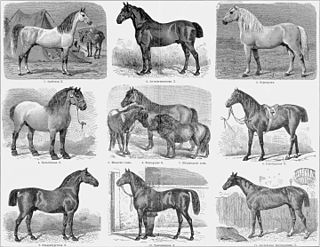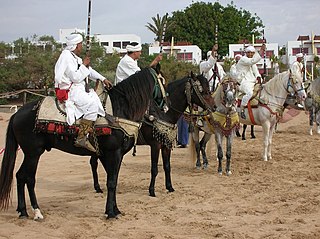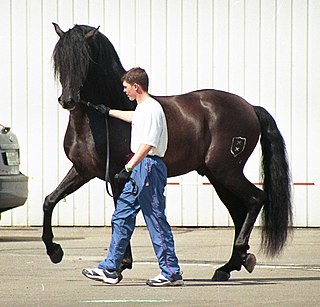Related Research Articles

A horse breed is a selectively bred population of domesticated horses, often with pedigrees recorded in a breed registry. However, the term is sometimes used in a broader sense to define landrace animals of a common phenotype located within a limited geographic region, or even feral "breeds" that are naturally selected. Depending on definition, hundreds of "breeds" exist today, developed for many different uses. Horse breeds are loosely divided into three categories based on general temperament: spirited "hot bloods" with speed and endurance; "cold bloods," such as draft horses and some ponies, suitable for slow, heavy work; and "warmbloods," developed from crosses between hot bloods and cold bloods, often focusing on creating breeds for specific riding purposes, particularly in Europe.

Horse breeding is reproduction in horses, and particularly the human-directed process of selective breeding of animals, particularly purebred horses of a given breed. Planned matings can be used to produce specifically desired characteristics in domesticated horses. Furthermore, modern breeding management and technologies can increase the rate of conception, a healthy pregnancy, and successful foaling.

A gelding is a castrated male horse or other equine, such as a pony, donkey or a mule. The term is also used with certain other animals and livestock, such as domesticated camels. By comparison, the equivalent term for a castrated male bull would be ox, or a wether for rams and billy goats.

Thoroughbred horse racing is a spectator sport in Australia, and gambling on horse races is a very popular pastime with A$14.3 billion wagered in 2009/10 with bookmakers and the Totalisator Agency Board (TAB). The two forms of Thoroughbred horseracing in Australia are flat racing, and races over fences or hurdles in Victoria and South Australia. Thoroughbred racing is the third most attended spectator sport in Australia, behind Australian rules football and rugby league, with almost two million admissions to 360 registered racecourses throughout Australia in 2009/10. Horseracing commenced soon after European settlement, and is now well-appointed with automatic totalizators, starting gates and photo finish cameras on nearly all Australian racecourses.

The Arabian or Arab horse is a breed of horse with historic roots on the Arabian Peninsula. With a distinctive head shape and high tail carriage, the Arabian is one of the most easily recognizable horse breeds in the world. It is also one of the oldest modern breeds. Although modern DNA cannot trace breed purity in the modern population beyond 200 years, there is archaeological evidence of horses in the Middle East with landrace characteristics that resemble modern Arabians dating back 3,500 years. Throughout history, Arabian horses have spread around the world by both war and trade, used to improve other breeds by adding speed, refinement, endurance, and strong bone. Today, Arabian bloodlines are found in almost every modern breed of riding horse.

The Cleveland Bay is a breed of horse that originated in England during the 17th century, named after its colouring and the Cleveland district of Yorkshire. It is a well-muscled horse, with legs that are strong but short in relation to the body. The horses are always bay in colour, although a few light hairs in the mane and tail are characteristic of some breed lines. It is the oldest established horse breed in England. The ancestors of the breed were developed during the Middle Ages for use as pack horses, when they gained their nickname of "Chapman Horses". These pack horses were cross-bred with Andalusian and Barb blood, and later with Arabians and Thoroughbreds, to create the Cleveland Bay of today. Over the years, the breed became lighter in frame as they were employed more as carriage and riding horses. The popularity of the Cleveland Bay has greatly fluctuated since it was first imported to the United States in the early nineteenth century. Despite serious declines in the population after the Second World War, the breed has experienced a resurgence in popularity since the 1970s, although only around 550 horses existed worldwide as of 2006.

The Barb or Berber horse is a North African breed of riding horse with great hardiness and stamina. It is closely associated with the Berber or Amazigh peoples of the Maghreb. It has influenced a number of modern breeds, including many in northern and western Africa.

The Lusitano, also known as the Pure Blood Lusitano or PSL, is a Portuguese horse breed. Horses were known to be present on the Iberian Peninsula as far back as 20,000 BC, and by 800 BC the region was renowned for its war horses. The fame of the horses from Lusitania goes back to the Roman Age, which attributed its speed to the influence of the West wind, who was considered capable of fertilizing the mares. When the Muslims invaded Iberia in 711 AD, they brought Arabian horses with them that were crossed with the native horses, developing a horse that became useful for war, dressage and bull fighting. The Portuguese horse was named the Lusitano, after the word Lusitania, the ancient Roman name for the region that modern Portugal occupies. There are four main breed lineages within the breed today, and characteristics differ slightly between each line.

The Azteca is a horse breed from Mexico, with a subtype, called the "American Azteca", found in the United States. They are well-muscled horses that may be of any solid color, and the American Azteca may also have Paint coloration. Aztecas are known to compete in many western riding and some English riding disciplines. The Mexican registry for the original Azteca and the United States registries for the American Azteca have registration rules that vary in several key aspects, including ancestral bloodlines and requirements for physical inspections. The Azteca was first developed in Mexico in 1972, from a blend of Andalusian, American Quarter Horse and Mexican Criollo bloodlines. From there, they spread to the United States, where American Paint Horse blood was added.
Secret Valley is an Australian children's television adventure series first shown on the ABC in 1980. It was produced by the Grundy Organisation in association with Telecip, S.A. and Spain's public broadcaster Televisión Española.
Catherine Field is a suburb of Sydney and part of the Macarthur Region in the state of New South Wales, Australia. Catherine Field is 43 kilometres south-west of the Sydney central business district, in the local government area of Camden Council.
Wooroloo is a town on the outer fringe of the Perth metropolitan region, located off Great Eastern Highway in the eastern part of the Shire of Mundaring. At the 2021 census, Wooroloo had a population of 2,613.

A stallion is a male horse that has not been gelded (castrated). Stallions follow the conformation and phenotype of their breed, but within that standard, the presence of hormones such as testosterone may give stallions a thicker, "cresty" neck, as well as a somewhat more muscular physique as compared to female horses, known as mares, and castrated males, called geldings.
An outbreak of equine influenza (EI) in Australia was confirmed by the Department of Primary Industries on 24 August 2007 in Sydney. Also known as "horse flu" and "A1 influenza", the rapid outbreak was of the Influenza A virus strain of subtype H3N8. While the virus is highly contagious, it rarely kills adult horses but the performance of thoroughbred racing horses can be affected for several weeks. It can be fatal to young foals and debilitated horses.

The Australian Equine and Livestock Events Centre (AELEC) is a multi building and arena complex that was designed for equine usage. It has two indoor arenas, stabling, plus an education and training building, which is located on the New England Highway approximately five kilometres south of the Tamworth Central Business District in the suburb of Hillvue.

The Andalusian, also known as the Pure Spanish Horse or PRE, is a horse breed from the Iberian Peninsula, where its ancestors have lived for thousands of years. The Andalusian has been recognized as a distinct breed since the 15th century, and its conformation has changed very little over the centuries. Throughout its history, it has been known for its prowess as a war horse, and was prized by the nobility. The breed was used as a tool of diplomacy by the Spanish government, and kings across Europe rode and owned Spanish horses. During the 19th century, warfare, disease and crossbreeding reduced herd numbers dramatically, and despite some recovery in the late 19th century, the trend continued into the early 20th century. Exports of Andalusians from Spain were restricted until the 1960s, but the breed has since spread throughout the world, despite their low population. In 2010, there were more than 185,000 registered Andalusians worldwide.

The Yeguada Militar de Jerez de la Frontera, known outside Spain as the Yeguada Militar, is a military Spanish stud farm headquartered in Andalusia, Spain, dedicated to horse breeding of purebred Andalusian horses and Arabian horses. Founded in 1847, it became the state military stud farm in 1893. In the 20th century, as need for cavalry horses declined, the stud's emphasis shifted to become a genetic reservoir to preserve the bloodlines of the Pure Spanish Horse and to continue to breed high quality Arabian horses, with stallions of both breeds being made available to private horse breeders to improve the horses of Spain. Today, there are two facilities located in the Jerez de la Frontera area, one primarily for stallions, the other for mares and foals, as well as multiple stallion depots across the country.
El Caballo Blanco may refer to:
El Caballo Blanco was the name for an equine Andalusian theme park and resort that operated in the north-eastern Perth suburb of Wooroloo in Western Australia from 1974.

The Carthusian horse, sometimes known as Cartujano in Spanish, is a bloodline group within the Purebred Spanish horse (PRE). The earliest lineages were tracked by 1476, leading to claims its breed registry is one of the oldest in the world. The Carthusian lineage descends from a gray stallion named Esclavo, who became the property of the Carthusian monks of Andalusia. The monks made a success of this breeding, which became famous throughout Europe in the 18th century. The Carthusian horse is morphologically distinguished from other PRE lines by its lighter body and straighter head profile, with the possible presence of bony protuberances. The Carthusian coat is usually gray. The Carthusian is used as a dressage horse and is well suited to combined driving. Carthusian breeding is concentrated in its birthplace, Andalusia, around Jerez de la Frontera, Badajoz and Córdoba.
References
- ↑ "El Caballo Blanco Website". 27 August 2007. Archived from the original on 27 August 2007. Retrieved 2007-08-27.
- ↑ "Flu outbreak hits star Sydney horses". The Sydney Morning Herald. 16 September 2007. Retrieved 16 September 2007.